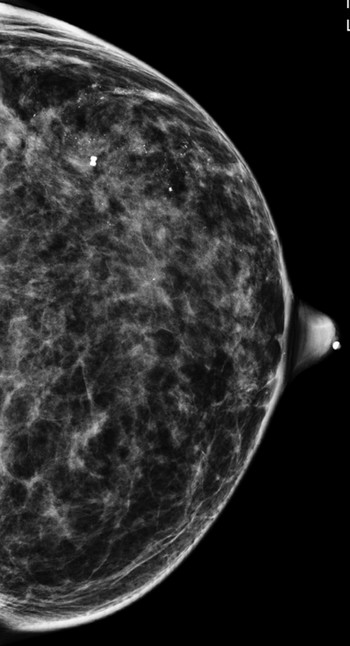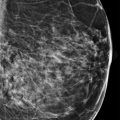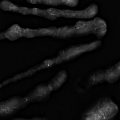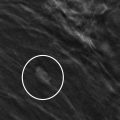Presentation and Presenting Images
( ▶ Fig. 92.1, ▶ Fig. 92.2, ▶ Fig. 92.3, ▶ Fig. 92.4, ▶ Fig. 92.5)
A 40-year-old female with a history of abnormal calcifications and a biopsy performed at an outside institution presents for diagnostic mammography and evaluation.
92.2 Key Images
( ▶ Fig. 92.6, ▶ Fig. 92.7, ▶ Fig. 92.8, ▶ Fig. 92.9, ▶ Fig. 92.10)
92.2.1 Breast Tissue Density
The breasts are heterogeneously dense, which may obscure small masses.
92.2.2 Imaging Findings
The imaging of the right breast is normal (not shown). The left breast demonstrates heterogeneous, pleomorphic calcifications measuring 8 cm with a regional distribution (wavy line in ▶ Fig. 92.6, ▶ Fig. 92.7, ▶ Fig. 92.8, ▶ Fig. 92.9, and ▶ Fig. 92.10). There is an associated postbiopsy clip (arrow) in the upper outer region of the calcifications; however, it does not demonstrate the extent of the calcifications. The calcifications extend from the base of the nipple to the pectoralis muscle and superior to inferior across the posterior nipple line.
92.3 BI-RADS Classification and Action
Category 6: Known biopsy-proven malignancy
92.4 Differential Diagnosis
Ductal carcinoma in situ (DCIS): Pleomorphic calcifications in a linear or segmental distribution are a typical appearance for DCIS. Calcifications associated with benign disease are generally more rounded and uniform in density and size.
Fat necrosis: Occasionally fat necrosis may demonstrate pleomorphic calcifications with an appearance that can be difficult to differentiate from malignancy. This differential is less likely given there is no history of trauma or surgery.
Pleomorphic lobular carcinoma in situ (LCIS): Pleomorphic LCIS may demonstrate imaging features that overlap with DCIS.
92.5 Essential Facts
Given the regional distribution and the pleomorphic morphology of the calcifications, ultrasound is recommended to evaluate for a mass lesion. Although no mass lesions were seen with DBT, it does not detect all masses.
When suspicious calcifications involve an area larger than 2 cm, it is helpful to biopsy near the ends of the calcifications, rather than just in a central group. This can provide the surgeon valuable information about the extent of disease and assist in making decisions about breast-conserving therapy or mastectomy options.
Although the calcifications are seen on DBT, the morphology and distribution of the calcifications are better evaluated with magnification views performed with conventional mammography.
DBT can perform spot-compression views, but not magnification views.
92.6 Management and Digital Breast Tomosynthesis Principles
DBT is superior in the detection of masses and architectural distortions but is limited in the evaluation of the distribution and morphology of calcifications.
Conventional two-dimensional (2D) mammography can more quickly detect calcifications and is better at evaluating the morphology and distribution of calcifications.
Calcifications are less easily appreciated and evaluated with DBT because calcifications can traverse multiple tomosynthesis slices.
One way to evaluate calcifications is to increase the width of the tomosynthesis movie slice.
92.7 Further Reading
[1] Spangler ML, Zuley ML, Sumkin JH, et al. Detection and classification of calcifications on digital breast tomosynthesis and 2D digital mammography: a comparison. AJR Am J Roentgenol. 2011; 196(2): 320‐324 PubMed

Fig. 92.1 Left craniocaudal (LCC) mammogram.
Stay updated, free articles. Join our Telegram channel

Full access? Get Clinical Tree








